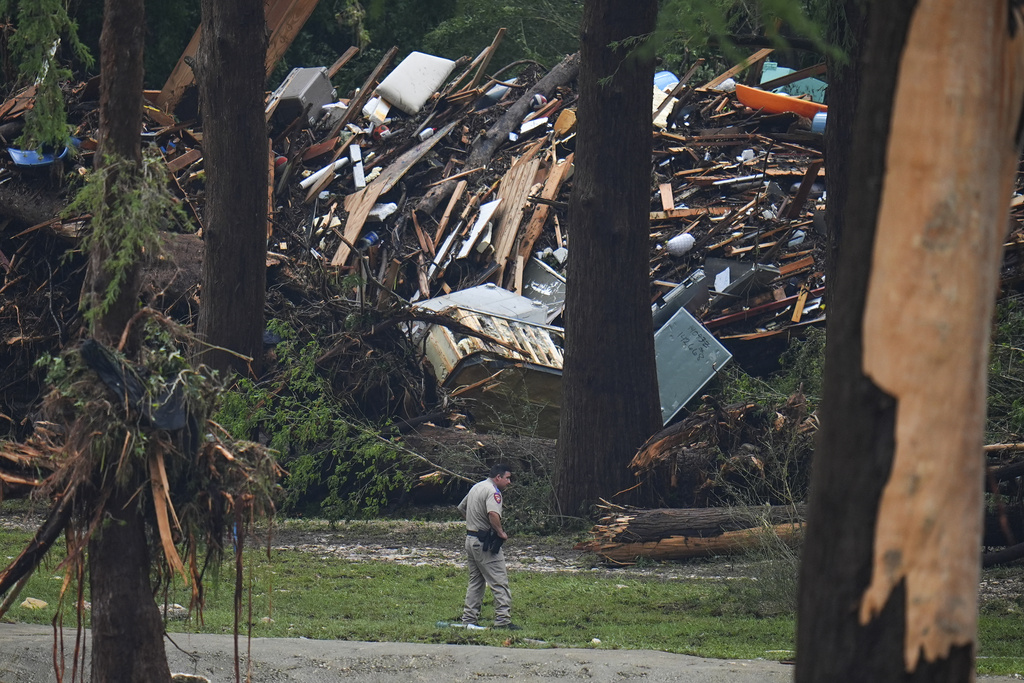Texas Flash Flood Fueled by Climate-Driven Storm \ Newslooks \ Washington DC \ Mary Sidiqi \ Evening Edition \ A slow-moving storm unleashed over 12 inches of rain in Texas Hill Country, sparking deadly flash floods. Experts link the extreme rainfall to climate change, which creates a more moisture-laden atmosphere. The storm left over two dozen dead and overwhelmed the region.

Quick Looks
- Location: Central Texas, mainly Kerr County in Hill Country
- Rainfall Total: Over 12 inches in just hours
- Time: Early Friday, during vulnerable overnight hours
- Fatalities: More than two dozen lives lost
- Geography: Flash flood-prone terrain with narrow river basins
- Drought Factor: Dry ground caused fast runoff, worsening flooding
- Storm Fuel: Moisture from Gulf, Pacific, and Tropical Storm Barry remnants
- Meteorologist Insight: Climate change adds more moisture, intensifies rainstorms
- Historical Comparison: Once-in-a-generation event, per climate experts
- Other Events: Similar flash floods in San Antonio, West Virginia recently
Deep Look
In the early hours of Friday morning, a historic weather system parked itself over Texas Hill Country, unloading over 12 inches of rain in just a few hours and unleashing deadly flash floods that left more than two dozen people dead. Scientists and meteorologists say the magnitude of the storm—and its timing—were a deadly combination fueled by an increasingly moisture-rich atmosphere shaped by climate change.
The storm’s development was a convergence of multiple meteorological and environmental factors. Moisture poured in from multiple directions: remnants of Tropical Storm Barry, warm air rising off the Gulf of Mexico, and moisture-laden currents from the Pacific Ocean. But unlike most weather systems that get carried away by the jet stream, this one stalled over Texas. The absence of the jet stream, a high-level atmospheric conveyor belt that typically moves weather systems along, allowed the storm to hover for hours and pour rain over the same areas again and again.
“This was a system with nowhere to go,” said Shel Winkley, a meteorologist with Climate Central. “It had no road to leave Texas. The result was relentless rainfall over already fragile terrain.”
The storm zeroed in on Kerr County, a region known for its natural beauty—but also its susceptibility to flash flooding. Sometimes referred to as “Flash Flood Alley,” the Hill Country’s shallow, rocky soil and steep topography create ideal conditions for water to accumulate and flow rapidly downhill. When heavy rain falls, the ground often can’t absorb it fast enough, and water rushes into narrow creeks and rivers, swelling them within minutes.
But this wasn’t just any storm. Experts believe this was a once-in-a-generation event. “As is often the case with the worst disasters, many things came together in a terrible way,” said Robert Henson, a meteorologist and science writer with Yale Climate Connections. The atmosphere was primed for rain, the ground was parched from prolonged drought, and the storm struck in the darkest hours of the morning—when most people were sleeping and unable to react.
This perfect storm dynamic—heavy rainfall over dry land—produces dangerous flash floods because parched soil acts like pavement. It repels rather than absorbs water. “It’s like trying to soak up water with concrete,” said Brett Anderson, a senior meteorologist at AccuWeather. “Instead of being absorbed, the water just runs off, gathering speed and volume as it moves downhill.”
The physical impact of the storm was staggering. Ryan Maue, former chief scientist at NOAA and now a private meteorologist, calculated that 120 billion gallons of water fell on Kerr County alone. That amount of rainfall in such a short span would test even the best-prepared communities, let alone a region with terrain ill-suited to slow the floodwaters.
Local emergency services were overwhelmed. First responders performed dozens of rescues, but many couldn’t be reached in time. Several children attending a nearby summer camp had to be saved from treacherous floodwaters, and at least one large-scale reunification center had to be set up for displaced families. The full extent of damage to homes, roads, and infrastructure is still being assessed.
But beyond the immediate tragedy, this event has reignited urgent conversations about climate change and its role in amplifying extreme weather. While meteorologists are cautious about attributing a single storm directly to climate change, there is strong scientific consensus that a warming atmosphere can intensify rainfall events. Warmer air holds more moisture—roughly 7% more for every degree Celsius of warming—so when storms develop, they often have more water to release.
“With climate change, we’re seeing a clear trend,” Winkley explained. “It’s not that we’re getting more rain overall, but the rain we do get comes in much more intense bursts. That’s exactly what we saw in Texas.”
This trend is being mirrored across the U.S. In June alone, deadly flash floods struck both San Antonio and West Virginia. In San Antonio, over 7 inches of rain fell within hours, leading to at least 13 deaths. In West Virginia, around 4 inches of rain in just 40 minutes triggered flash floods that killed nine people near Wheeling. These aren’t isolated anomalies—they’re part of a broader pattern of weather events becoming more intense and less predictable.
In Texas, the consequences are especially dire because of rapid development in flood-prone regions. As more people move to scenic parts of Hill Country, often building homes along creeks and rivers, the risks grow. Inadequate infrastructure and limited early-warning systems exacerbate the problem. Urban sprawl has also increased the amount of impermeable surfaces, like concrete and asphalt, that accelerate runoff into waterways.
Experts are now calling for a fundamental rethinking of how communities prepare for such disasters. That includes upgrading drainage systems, investing in more resilient infrastructure, improving floodplain mapping, and designing more responsive emergency alert systems. Public awareness campaigns may also be necessary to educate residents about the increasing risks and the importance of preparing for flash floods—especially those that strike at night.
Local leaders and climate scientists are urging Texas lawmakers to prioritize climate resilience in policy decisions. The state, long wary of climate science in politics, now finds itself at the epicenter of its consequences. Drought, wildfire risk, extreme heat, and flash flooding are colliding to create overlapping crises that challenge emergency responders, displace families, and strain local economies.
“If this storm teaches us anything,” said Anderson, “it’s that we’re living in a different climate than we were a few decades ago. We can’t rely on old assumptions about weather patterns anymore.”
Beyond Texas, the implications of this storm are global. From monsoons in South Asia to hurricanes in the Caribbean, warming oceans and rising temperatures are altering precipitation patterns and storm behavior everywhere. These events are not just weather stories—they are human stories, marked by lives lost, homes destroyed, and communities forever changed.
As the skies clear over Texas Hill Country and the region begins its long road to recovery, the conversation now turns to what can be done to prevent the next disaster. Climate change isn’t a distant threat—it’s here, reshaping the weather, rewriting the rules, and leaving devastation in its path.
Texas Flash Flood







